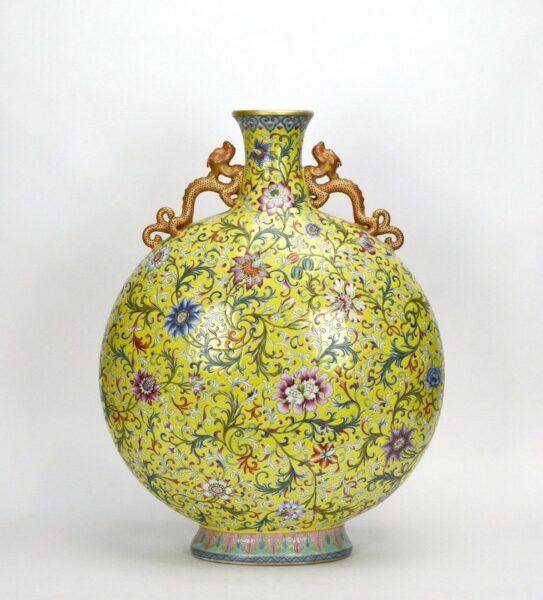#Collectors #Moon #Porcelain #Flasks #WorthPoint

The moon has always been an object of contemplation and wonder. It has also been a muse for artists in all mediums.
The moon has a special meaning in Chinese culture and symbolizes peace, prosperity, and family reunion; it is also the subject of many legends and poems. Talented ceramic artisans also designed a special vessel in its shape: the moon flask. These hand-painted flask-shaped vases are known as “baoyue ping,” which translates to “embracing the moon.”
Collectors enthusiastically embrace these vases today as beautiful decorative objects and for their historical significance. Some examples are also highly valuable: two rare moon flasks sold in 2023 for millions—one by Christie’s and one by Sotheby’s.
MIDDLE EASTERN INFLUENCE
The moon flask (also spelled moonflask) is characterized by a circular body—thus its name—narrow cylindrical neck, flat base, and two arched side handles, which create an “embrace” between the body and neck. These vases required an exceptionally high level of technical skill to make. They were heavy, hard to fire, and at risk of collapsing in the kiln, particularly the pieces made for the Chinese emperors and Imperial households, often over 20 inches high.
Moon flasks were inspired by the Middle Eastern metalwork water flasks that travelers carried and imported into China along the Silk Road. In the West, they are traditionally known as pilgrim’s flasks.

This flask form first appeared in Chinese pottery during the Tang dynasty (618-907) and became firmly established as a standard ceramic shape during the Song dynasty (960-1279). Often used to carry holy water and oils, the vases’ full-moon surfaces were used to hand-paint symbolic designs, including dragons and flowers, in blue and white for Chinese Imperial palaces. The Middle Eastern influence was also seen in many other designs, like flowering stems, stylized blooms, and leafy fronds reminiscent of Islamic arabesques.
The flask evolved into a highly decorative object during the Ming era (1368-1644), and the style was later reproduced during the Kangxi (1661-1722) and Yongzheng (1722-1735) periods. Moon flasks regained dominance during the reign of the Qianlong Emperor (1735-1796), who liked to revive styles from the past.
New shapes and designs were invented as the Imperial kiln experimented with new firing techniques and glazes, including blue, copper-red, lime green, turquoise (the rarest), and yellow.
BRITISH POTTERS ADD THEIR SPINS
After Japanese artists eventually started making moon flasks, the craze for Japonisme in Europe helped the vases to be introduced there, and European potters crafted them in various styles and designs. During Britain’s Aesthetic era in the late 19th century, the moon flask was one of the most popular forms of art pottery.

A number of British companies produced moon flasks that are popular with collectors today, including Minton Pottery, a major company in Staffordshire pottery and a leader in ceramic design during the Victorian era. Minton produced work using many different decorative techniques and styles, like art nouveau, Asian, Rococo, and a variety of forms.
The company also used the moon-flask shape for pâte-sur-pâte designs, as its circular form provided a “canvas” for artists to express their creativity. Moon flasks were also a favorite shape at Minton’s Art Pottery Studio in London.
One of Minton’s top innovative designers in the mid-1860s was Christopher Dresser. A major figure of the Aesthetic Movement, Dresser is considered the first industrial designer and is often regarded as Britain’s most important designer of the 19th century. Inspired by Japanese art, some of Dresser’s early designs for Minton included bone china moon flasks with Japanese decorative motifs.
Dresser also designed moon flasks for Royal Worcester, another English company that gained recognition for its Japanese-inspired designs.

Doulton of Lambeth Pottery also produced moon flasks, often in pairs, by artists including John Eyre, the art director, Hannah Barlow, Ada Dennis, Esther Lewis, Katherine Sturgeon, and Linnie Watt. These artists and others decorated several different styles of moon flasks with the Faience technique and painted border designs; scenes of children in rural settings were a popular motif. The moon-flask form can also occasionally be found in Doulton Lambeth Burslem art wares and stoneware. The company’s large blue and white Burslem moon flasks are evocative of the pieces made by Chinese and Japanese artists.
COLLECTING MOON FLASKS
One of the most popular porcelain vase shapes sought by collectors, moon flasks can be found in various colored glazes and hand-painted decorations, including cranes and other birds, dragons, flowers, fruit, Islamic-inspired motifs, Japanese-inspired designs, and pastoral scenes.
Pretty much any antique or vintage moon flask is collectible, whether made by British, Chinese, or Japanese potters, but some examples are more valuable than others. Some command sky-high prices because of the skill required to make moon flasks, particularly large pieces. The most expensive moon flask recorded in WorthPoint’s database is $903,750 for an extremely rare and large vase sold in 2014 by WorthPoint’s partner, Freeman’s. The monumental flask embodies the refinement in ceramic craftsmanship of Qing imperial potters during Emperor Yongzheng’s reign.
Two other large and scarce moon flasks sold for millions in 2023: a doucai-painted “dragon” moon flask sold at a Christie’s Hong Kong sale for $13.8 million, while a Yongle black and white flask sold at Sotheby’s for $10.9 million.
Collectors can find more affordable pieces at auctions and e-commerce sites, including eBay, Etsy, and Mercari. Many flasks are in the $10 to $100 range, especially for examples made in the 20th century and later, and can go up to hundreds of thousands from there, depending on their rarity, decoration, glaze, and size.
Elegant and finely crafted moon flasks add timeless lunar-inspired beauty to any collection or home décor.
Adina K. Francis has been a writer and editor in the antiques and collectibles field for more than 20 years. he has a bit of an obsession with the Victorians and thinks that dogs are one of life’s greatest gifts.
WorthPoint—Discover. alue. reserve.



